Are you searching for a ready-made Action Research Project Report for your B.Ed. course? Here I am sharing a complete ready-made sample Action Research Project in Mathematics for B.Ed. students. This research proposal is specially made for B.Ed. trainee. This model action research project will also help you understand how to prepare your action research.
Action Research Project Report for B.Ed. in Mathematics [For Practical File]
As mentioned above, I will share a complete Action research Proposal/Project/Report in this post with you. This will be very helpful for you if you are a B.Ed. trainee or any teacher to conduct and submit an action research report in your B.Ed. institution. but before that let’s understand what is an Action Research.
What is Action Research?
Action research is a purposeful and goal-oriented activity undertaken by practitioners with the purpose of improving and modifying their practices to achieve better results. Action research in the educational field is research undertaken by teachers or educators to improve their teaching practices.
In simple words, Action research is a type of investigation or small research done among the students of a particular class to solve the problem students face during their learning. Action Research helps in building new strategies for teaching and hence improves the efficiency of the teaching-learning process.
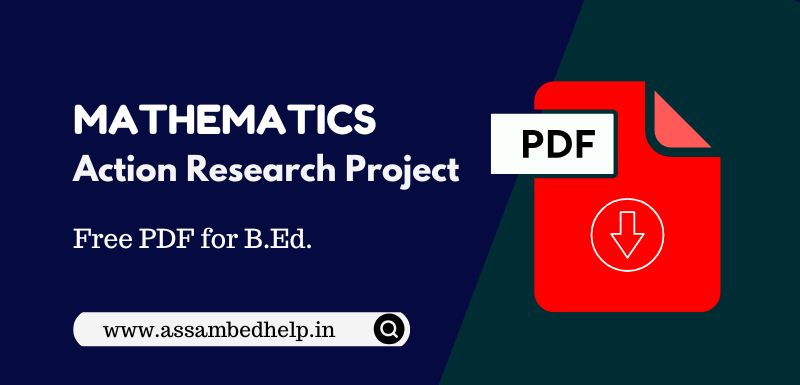
I have taken the topic of this action research project on ‘Attention problem in learning general mathematics among the class VII students”. Since this is just a sample action research proposal, you can pick any other topic that you want to research or investigate. Otherwise, you can copy-paste this action research project for submission in your B.Ed. institutions.
Model Action Research on Attention Problems in Learning General Mathematics Among the Class 7 Students
While making this action research project we will follow the following steps. This action research report has been made by following the proper steps for making an action research project. You can just follow the below-mentioned steps while making your action research project.
PREFACE
The action research entitled “Atten Problems in Learning Mathematics Among The Class 7 Students.”
This report is presented in four chapters, each dealing with certain topics—-
- Chapter 1- INTRODUCTION
- Chapter 2- METHODOLOGY
- Chapter 3- ANALYSIS AND INTERPRETATION OF DATA
- Chapter 4- FINDING AND CONCLUSION
- BIBLIOGRAPHY and APPENDICES are presented in a systematic order at the end.
CONTENTS
- Chapter 1- INTRODUCTION
- Introduction
- Title of the study
- Significance of the study
- Objectives of the study
- Statement of the problem
- Probable cause of the problem
- The hypothesis of the study
- Chapter 2- METHODOLOGY
- Methodology
- Population
- Sample
- Tools
- Techniques
- The procedure of collection of data
- Time period
- Action Research Design
- Action Program
- Chapter 3- ANALYSIS AND INTERPRETATION OF DATA
- The procedure of analysis of data
- Analysis and interpretation of data
- Chapter 4- FINDING AND CONCLUSION
- Findings of the study
- The action was taken on the findings of the study
- Suggestion
- Conclusion
- BIBLIOGRAPHY
- APPENDICES
CHAPTER 1- INTRODUCTION (Action Research Project For B.Ed.)
1.1. Introduction:
Attention is focused concentration it is a concept studied in cognitive psychology that refers to how we actively process specific information in our environment. But it is not just about centering your focus on particular things, it also involves ignoring a great idol of competing for information and stimuli. Attention allows you to ‘tune out’ information, sensations, and perceptions that are not relevant at the moment and instead focus your energy on the important information.
Attention is the first step in the learning process. We can’t understand, learn, or remember that which we don’t first attend to
According to eminent psychologist and philosopher William James—
“Attention is the taking possession by the mind, in clear and vivid form, of one out of what may seem several simultaneously possible objects or trains of thought….. It implies withdrawal from some things in order to deal effectively with others.”_ “The Principles of Psychology,”1890.
According to John Ratey (2001), attention is more than just noticing incoming stimuli. It involves a number of processes including filtering out perceptions, balancing multiple perceptions, and attaching emotional significance to these perceptions.
1.2. Title of The Study:
A Study on “ATTENTION PROBLEM IN LEARNING GENERAL MATHEMATICS AMONG THE STUDENTS OF CLASS VII,” North Lakhimpur Town High School.
1.3. Significance of The Study:
The investigator did this research mainly to evacuate the attention problem in learning General Mathematics among the students of class VII. They must be energized and commended in General Mathematics class to learn General Mathematics for their best success. The investigator needed the dimension of support of the understudy in the class to ascend from once-in-a-while decent to consistently incredible because to achieve accomplishment in any area each understudy must be increasingly genuine mindful normal and cognizant about his study. Students who get their work done routinely and focus in the study hall show better execution in their outcomes.
The essential objective of the investigator or researcher in this present study is to advance consideration in the study of General Mathematics and motivate students to learn General Mathematics and furthermore to be mindful of the significance of General Mathematics for improving the maximum capacity of each individual, group, and network in the society.
1.4. Objective of The Study
The study will focus on the following objectives—
- To discover the causes behind the consideration issue in Mathematics among the class VII students.
- To assess the attention regarding their reactions to their provided questions.
- To build up the system for expanding the consideration dimension of the understudies.
- To empower the students to make models, graphs, and ventures identified with mathematics.
- To make the students interested by the consideration dimension of the understudies.
- To develop a curiosity to ask questions during the teaching-learning process.
- To make them understand the significance of the subject of General Mathematics.
1.5. Statement of The Problem:
When I went to teach the General Mathematics subjects in VII of North Lakhimpur Town High School, Lakhimpur, 5 students out of 65 students were not attentive in the classroom. I saw that other students were getting disturbed by that student. So, I decided to prepare an Action Research Work in Mathematics on this topic.
Attention Problem in Learning General Mathematics Among The Class VII Students. (Action Research Project in Mathematics for B.Ed.)
1.6. Probable Causes of The Problem:
The investigator had listed the following PROBABLE causes of the attention problem of the students while teaching General Mathematics—
- The attitude of the students towards the mathematics subject isn’t effective.
- Improper method of teaching.
- The students have issues with memory expertise and focus.
- Due to the lake of lively environment.
- Lack of cooperation among students.
- Lack of freedom doing activities.
- Because of the theoretical nature of mathematics students appear to be absent-minded.
- Lack of appreciated teaching aids.
- By using a faulty method of teaching.
- Cannot be co-relate numerical points with life.
- Cannot take an interest in any mathematical activity.
1.7. Hypothesis of The Study:
If the problem area due to the “attitude” of the students towards the mathematics subject is not effective”, “cannot co-relate mathematics topic with life”, ‘’cannot participate any mathematical activity”, it can be minimized and ultimately they will be able to pay attention in the mathematics subject.
CHAPTER 2- METHODOLOGY
2.1. Methodology:
As far as the present study is concerned it is a descriptive type of study. So as to direct this study descriptive survey method was chosen as the proper one for this reason. Elucidating exploration studies have been intended to get relevant and exact data concerning the present status of wonder and at whatever point conceivable to reach legitimate general determinations from the reality found. Distinct research isn’t just limited to actual findings but may frequently result in the detailing of significant standards and arrangement of noteworthy issues. Accordingly, an unmistakable technique was observed to be reasonable for the present study conducted.
2.2 Population:
All the students of class VII were the population of study i.e. 65
2.3 Sample:
Of the 65 students of class VII, 5 students were selected for the study.
List of students for sample collection:
| Sl. No. | Name of The Students | Roll No. |
|---|---|---|
| 1 | Bhargav Baruah | 2 |
| 2 | Nipu Guwala | 10 |
| 3 | Irfan Husain | 26 |
| 4 | Tanuja Das | 30 |
| 5 | Sarat Chutia | 58 |
2.4 Tools:
- Observation
- Pre-test and Post-test
- Interview
2.5 Techniques:
We use quantitative techniques are- Percentage and Average
2.6. Procedure of Data Collection:
The collection of data is the major activity of the research work. In this case the Headmistress of N.L. Town High School left us free to collect the data from the students. The present study was limited to the students of class VII of the school. In this study, a systematic procedure was followed in the collection of data.
At the very beginning of the practice, many problems were found in the classroom but a major problem among the students of class VII was students’ attention problem in learning mathematics. To deal with that issue, an attempt was made.
In the first phase of the collection of data, an achievement test was conducted which was taken by the oral process by questioning based on the class topic. Out of 65 students, 5 students did not answer the questions. After collecting the sample an interview was conducted among the 5 students. A question paper was set to look into the Attention Problem.
After one month, to collect improvement data again a post-test was taken by questioning which was conducted by oral process among the 5 students based on another class topic.
2.7 Time Period:
The time of the study was from 11th March to 15th May 2021.
2.8. Action Research Design:
The design of the present study is –
Observation—— Pre-test—— Interview —— Invention —— Post-test
An observation procedure was used. Then a pre-test was conducted on the population using the oral questions based on the class topics. Then an interview was conducted on the problem faced by students. After that interventions were implemented in the sample to eliminate the most probable causes for one month. After one month, a pre-test was conducted on the sample using oral questions based on another class topic.
2.9. Action Programme:
During my internship teaching the General Mathematics subject at North Lakhimpur Town High School in class VII, it was found that some students were inattentive in the classroom. So, I decided to take action to overcome the problem.
At first, I observed the students who faced attention problems. Then to collect the data, a pre-test was taken by questioning which was conducted by oral process based on the class topic among all students. After collecting the sample, an interview was taken to detect the causes of the Attention problem. Then I took some measures to overcome that. For the e.g.-improving the attitude of students towards Mathematics subjects involved them various mathematical experiments etc.
For this action taken, improvement came to the student’s attention. It was detected from the posttest taken by questioning which was conducted by oral process based on another class topic among the sample.
CHAPTER 3-ANALYSIS AND INTERPRETATION
3.1. Procedure of Analysis of Data:
An interview was conducted among the 5 students who were inattentive in the class. The question paper of the interview is shown on the last page.
The quantitative method is used to analyze the data. Appropriate statistical tools and tables were used to present the data in an organized way.
- Tabulation of the response to the interview.
- Presentation of the data with the help of a bar diagram showing their response in the interview.
In the section on Analysis and Interpretation of Data, data were systematically presented to reflect the responses of the students in the interview.
3.2. Analysis and Interpretation of Data:
Table:- Number of respondents who answered ‘Yes/No’ in the interview –
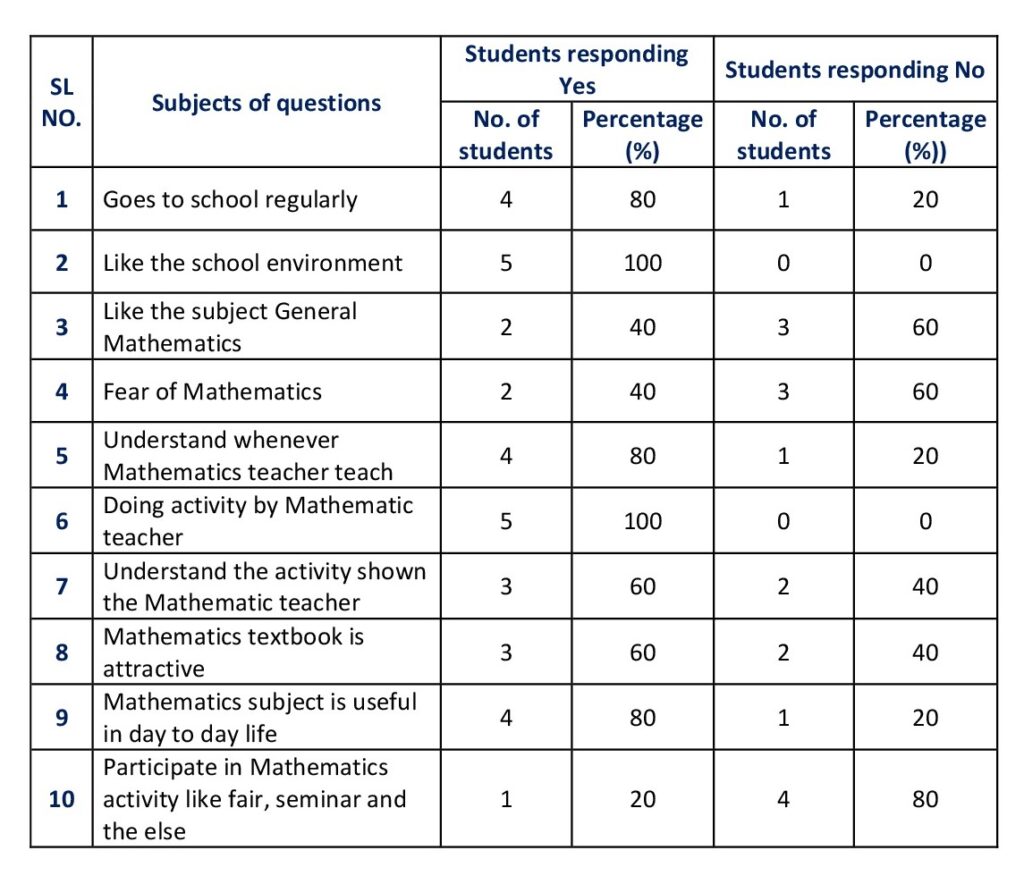
Graphical Representation of the above Data:
Bar diagram of student’s response – BAR DIAGRAM:
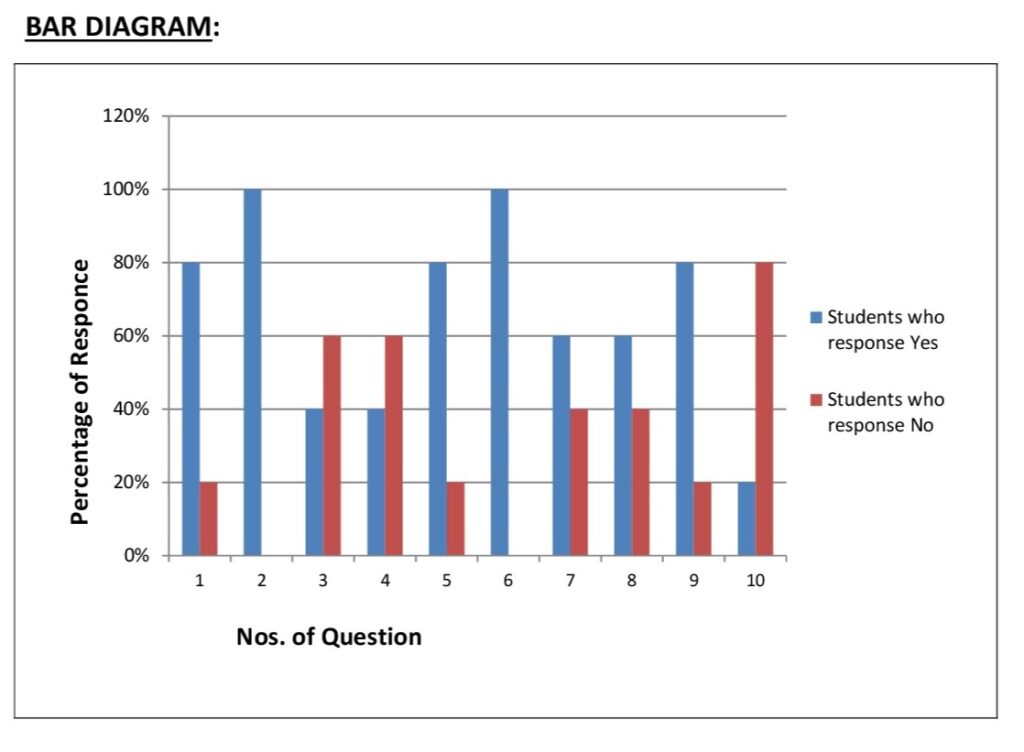
From the Table and Bar Diagram, we found that—–
- From the 1st response, among the 5 students, 80% go to school regularly, while 20% do not go to school regularly.
- From the 2nd response, 100% like the school environment, and nobody dislikes the school environment.
- From the 3rd response, 40% of them like the subject of General Mathematics, but 60% dislike it.
- From the 4th response, 40% of students have a fear of Mathematics, while 60% have not.
- From the 5th response, 80% of students understand whenever their Maths teacher teaches, and the other 20% don’t understand.
- From the 6th response, 100% of students responded ‘Yes’ to their Mathematics teacher doing an activity.
- From the 7th response, 60% of the students understand the activity shown by the Mathematic teacher and 40% do not.
- From the 8th response, 60% of students responded ‘Yes’ that their Mathematics textbook is attractive and 40% responded ‘No’.
- From the 9th response, 80% of the students know that the Mathematics subject is useful in day-to-day life and the other 20% don’t know.
- From the 10th response, 20% of the students have not participated in Mathematics activities like fairs, seminar and 80% of the students have not participated in any Science activities.
CHAPTER 4- FINDING AND CONCLUSION
4.1. Finding of The Study:
- From the above bar diagram, it is found that out of five students, 3 students don’t like the Mathematic subject, they have a fear of Mathematics because their attitude towards the Mathematic subject is not effective.
- It is also found that out of 5 students, only 1 student has participated in Mathematical activities like seminars and the others, and the rest 4 have not because they cannot relate mathematic topics with life.
- In this action research proposal/project/report, it was found that taking remedial measures with well-equipped TLMs, audio-visual aids, and drill and classroom activities has shown a good achievement level of student performance.
- From the study, when I compared the average percentage of pre and post-achievement tests of the samples taken, it was found that this percentage has shown massive improvement.
- From the above result, it was proved that the action hypothesis is true and valid.
4.2. Action Taken on The Findings of The Study:
To minimize these problems I have taken some measures –
- We have used proper teaching aids to motivate the students toward Mathematics.
- Quick corrections while they make mistakes should practically be done.
- We gave significance to individual differences and tried to satisfy the requirements of the understudies however much as could be expected.
- The researcher always helped the students personally to solve their problem in Mathematical problems.
- The researcher always ensured the classroom atmosphere was conducive to learning.
4.3. Suggestion:
Attention problem in a classroom is an important problem. In the Mathematics class, to overcome this problem I suggest that the teacher should motivate the students toward Mathematical topics with various life-related questions. This step helps students to know that Mathematics is related to our day-to-day life. The teacher should use various teaching aids like Mathematical models, charts, etc to attract the students and activities also do in the class. I suggest the students take participation in Mathematical activities like fairs, seminars, etc.
4.4 Conclusion of The Action Research Project:
There is clear evidence to suggest that action research is a valuable exercise for teachers to understand students’ problems. It offers teachers a systematic collaborative process of inquiry that actively seeks to address the issue.
The study attempts to analyze the specific and immediate problem faced by pupils of VII and the factors responsible for the particular problem. The study was undertaken to understand whether the teaching strategies have been specifically designed or if any social, environmental, and economic factors are responsible for the cause of the specific problem.
Thus, the study aimed to actively participate in the underlying situation and resolve immediate action to minimize the difficulties while simultaneously conducting the research.
BIBLIOGRAPHY:
- Hopkins David, 2002(3rd Edition), A Teacher’s Guide to Classroom Research, Open University Press.
- Sagor Richard, 2000, Guiding School Improvement With Action Research, Association For Supervision and Curriculum Development.
- Strong James H., Tucker Pamela D., Hinduman Jennifer L., Handbook for Qualities of Effective Teachers.
- https://www.verywellmind.com/what-is-attention/
Appendix: 1 (Pre-Test Paper of The Math Action Research)

Appendix: 2 (Interview for the Action Research in Mathematics)
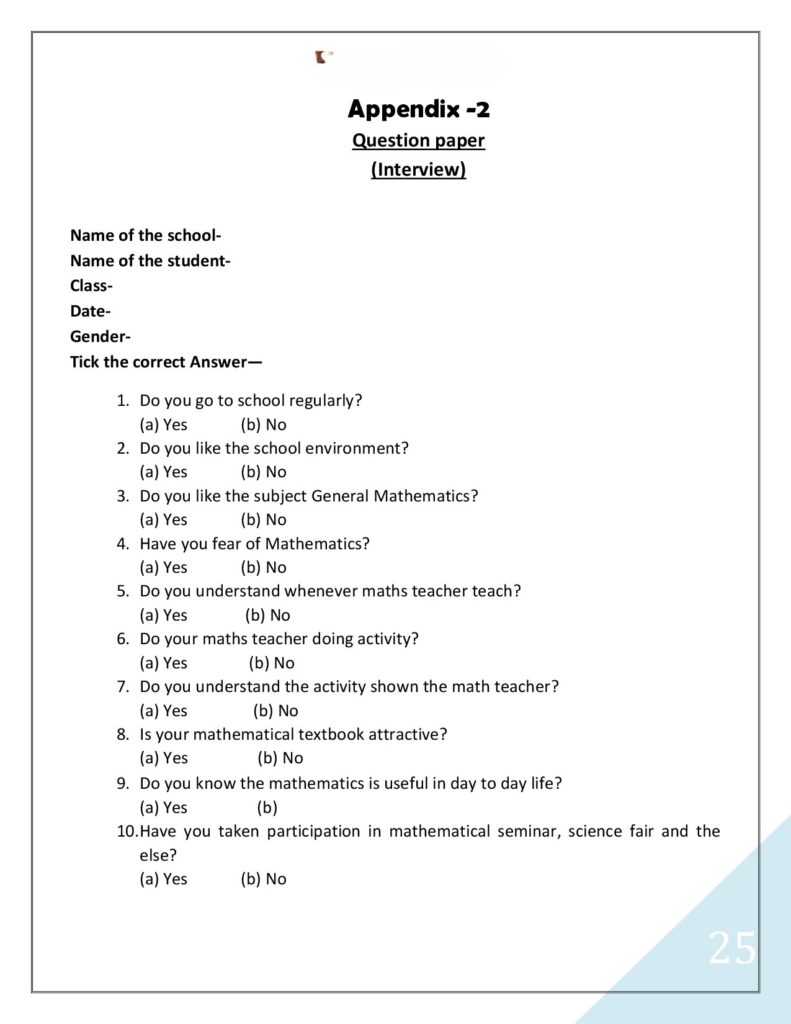
Appendix: 3 (Post-Test Paper)
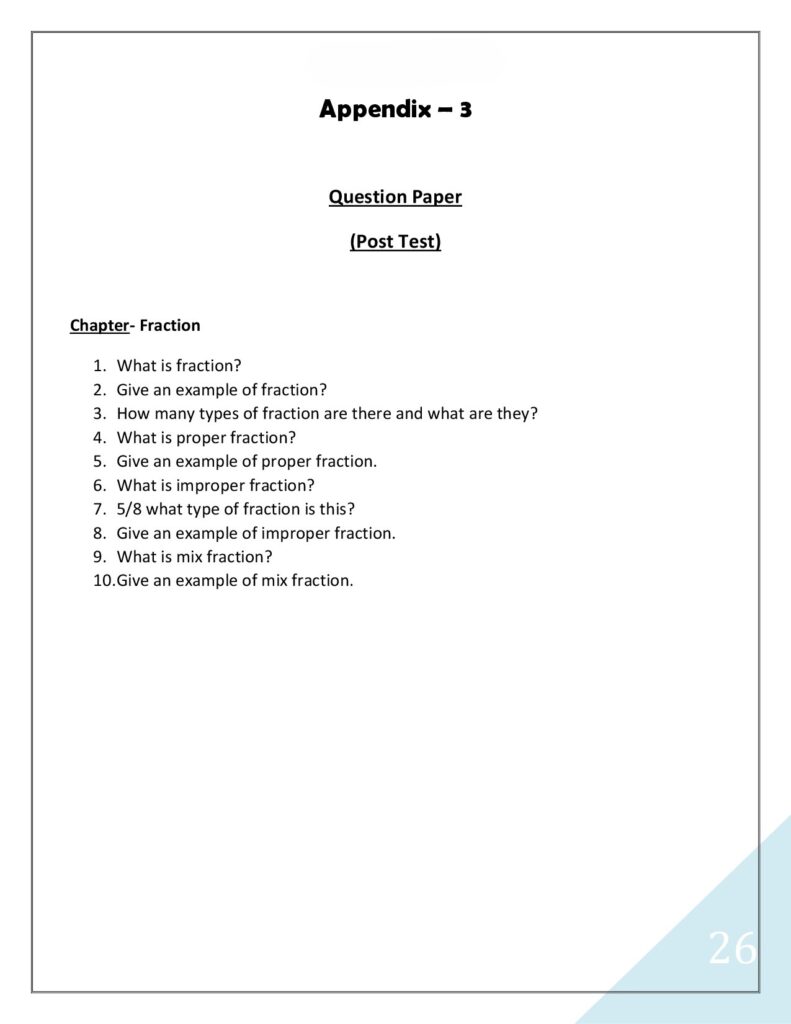
List of Tables:
| Table No. | Title | Page No. |
|---|---|---|
| 1 | Number of Respondents Answered “Yes/No” in the Interview | Insert Page No |
List of Graphs:
| Graph No. | Topic | Page |
|---|---|---|
| 1 | Bar Diagram of Students Response | Insert Page No. |
List of Appendices:
| Appendix No. | Topic | Page |
|---|---|---|
| 1 | Question Paper (Pre-Test) | …… |
| 2 | Question Paper (Interview) | …… |
| 3 | Question Paper (Post-Test) | …… |
PDF of Action Research Project File on Attention Problem in Learning Mathematics For B.Ed.
The above action research project may require help to read. I have given the PDF version of this Action research project in mathematics for your convenience. This PDF of the action research report has 27 pages in it.
Above I have given the complete Action Research Proposal/Project/Report in mathematics. The topic of this Action research project which is done for the mathematics subject is on the topic “Attention Problem in Learning Mathematics Among The Class VII Students”. I have given the investigated data of five students of class 7.
If you wish to investigate with more students to complete your Action research report proposal or project, then you are free to do it. I have only been given a sample Action research project in mathematics for my B.Ed. practicum course. The PDF version of the above Action Research Project is given below.
FAQs
Action research in the educational field is research undertaken by teachers or educators to improve their teaching practices.
Problem on learning general mathematics among the students of class 7.
There are four main steps. These are
1. Introduction (Finding the Problem).
2. Methodology.
3. Analysis and Interpretation of data.
4. Findings and Conclusion